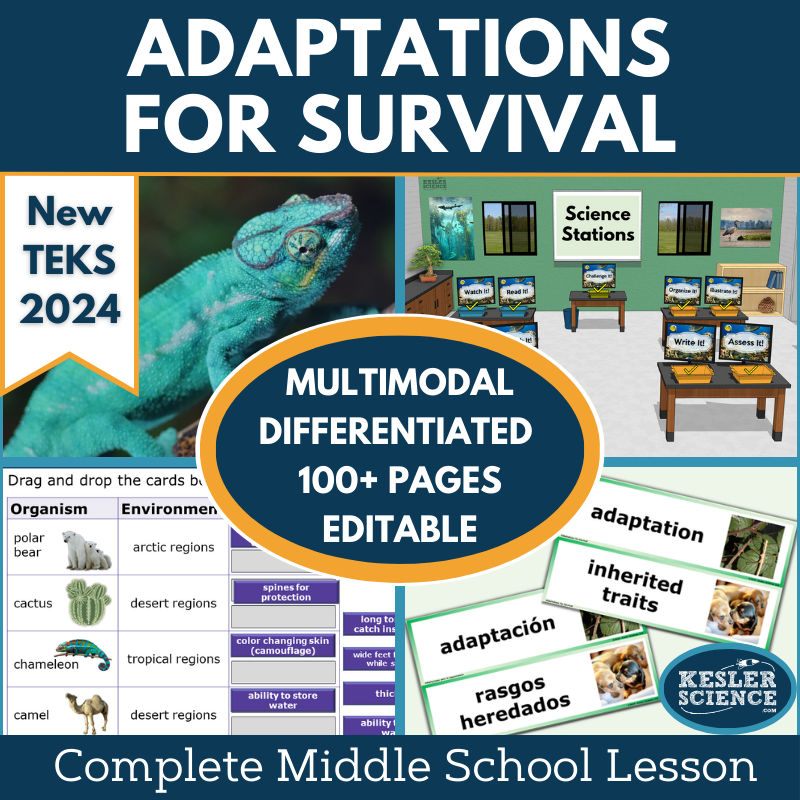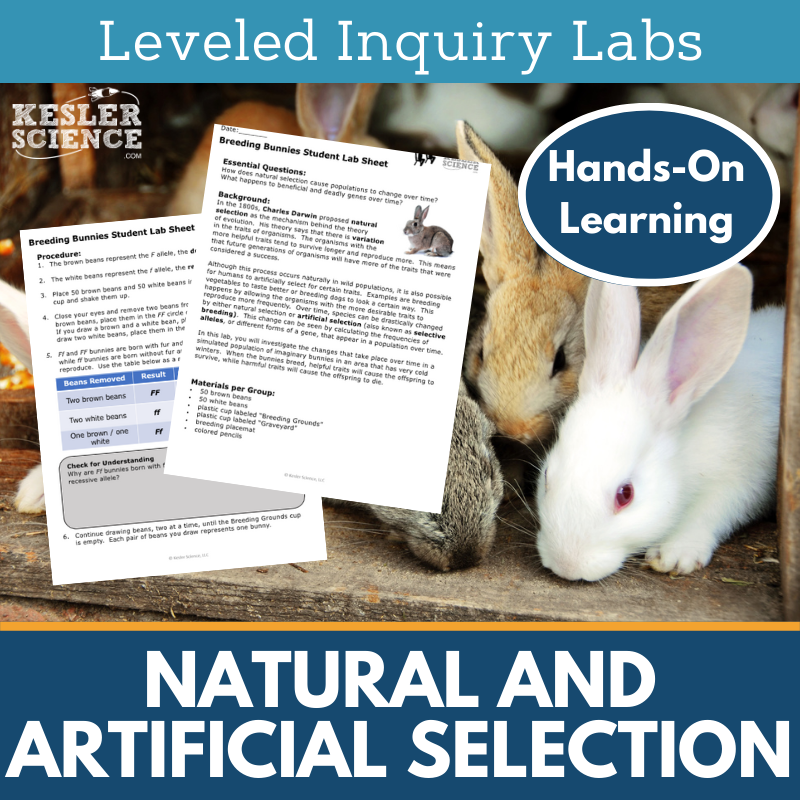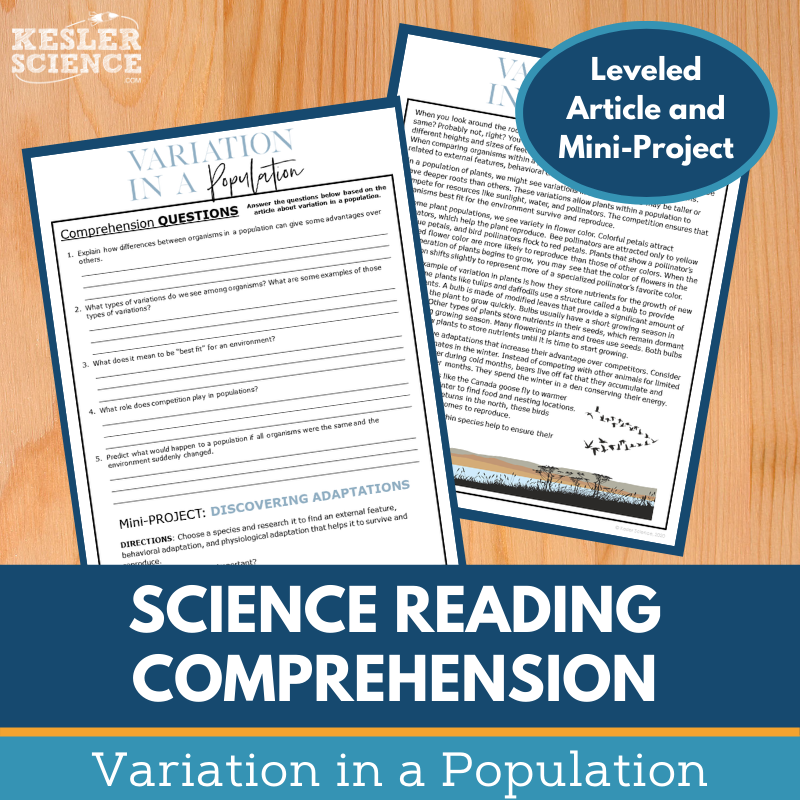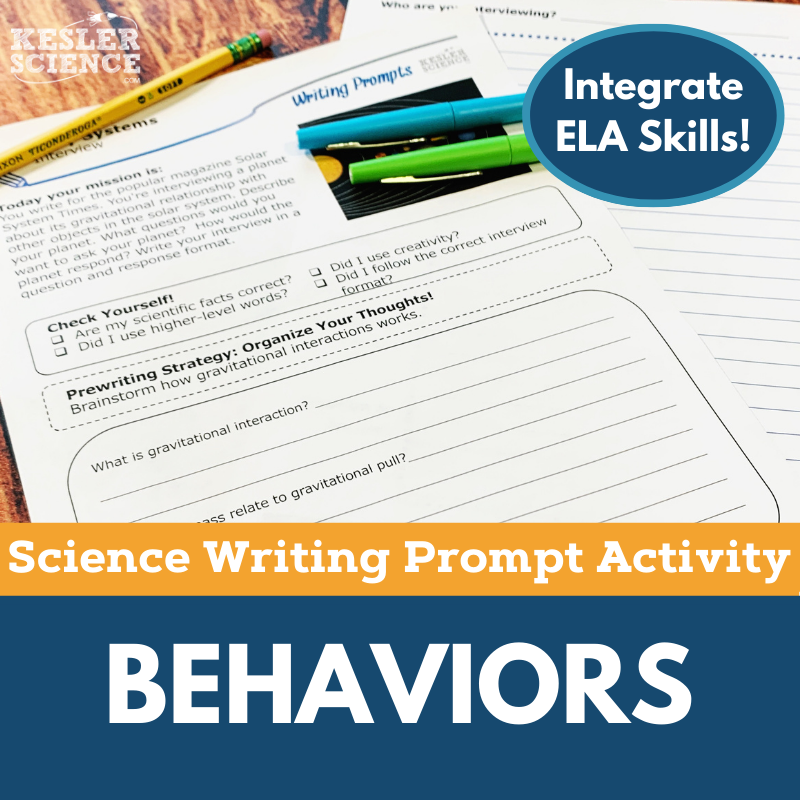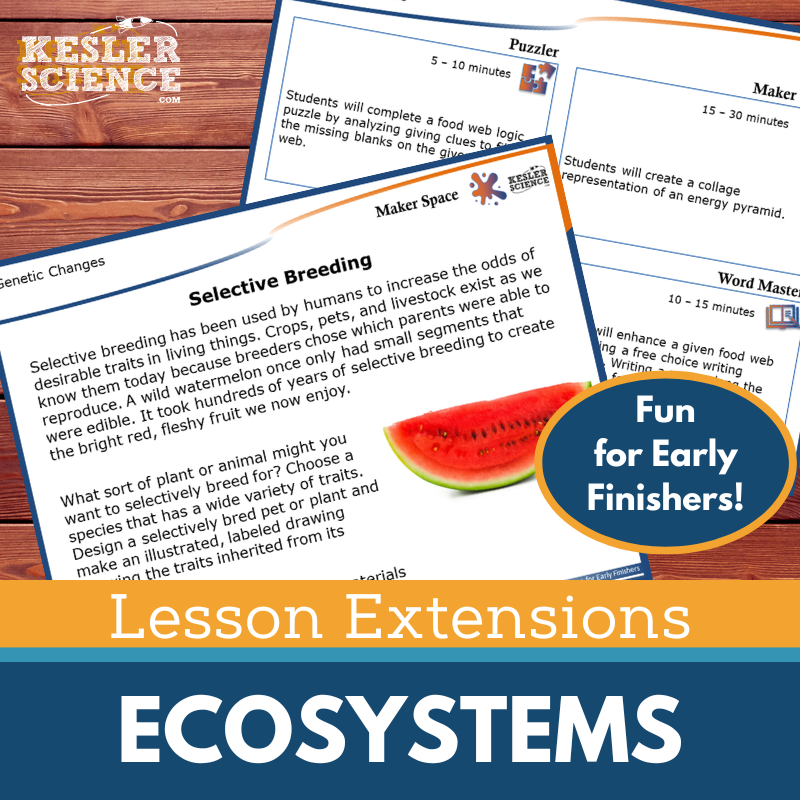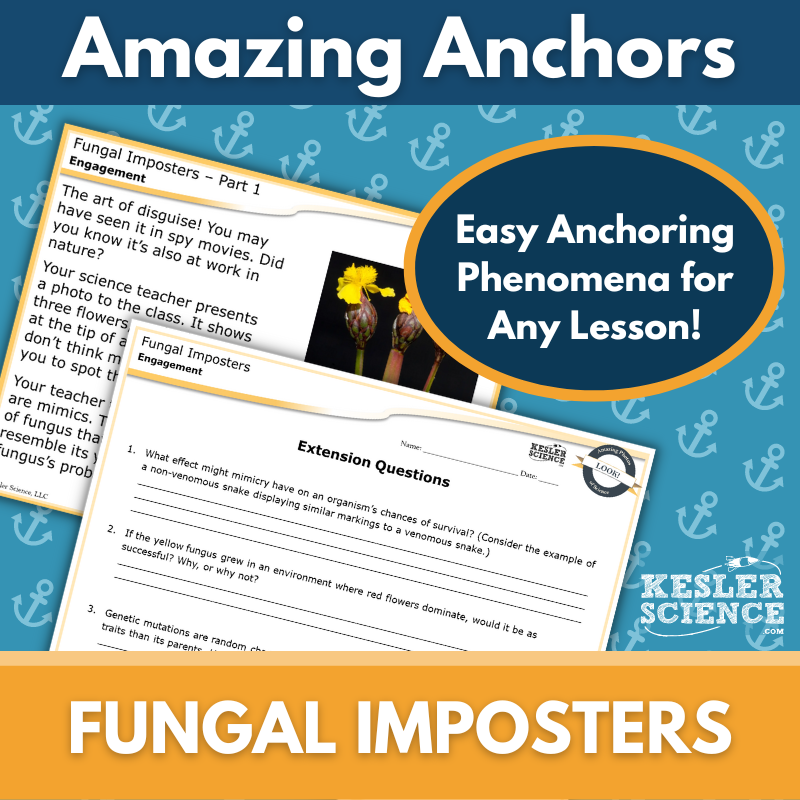Adaptations for Survival Activities for Middle School Science
Understanding how variations in traits lead to adaptations for survival can be complex for middle school students, but these engaging materials make it easier to explore! The resources below will give students a comprehensive understanding of adaptations for survival. All of the following materials are also included in the Kesler Science Membership.
The Kesler Science Adaptations for Survival 5E Lesson is a complete middle school life science unit designed to help students explore how variations in traits within a population lead to structural, behavioral, and physiological adaptations that influence survival and reproductive success. This fully editable, low-prep resource includes PowerPoint presentations, worksheets, differentiated station labs, and assessments, providing student-led learning opportunities that align with TEKS 8.13C. With flexible digital and print formats, Spanish translations, and multimodal activities, this lesson ensures accessibility for all learners.
This 5E lesson guides students through each phase of learning. Engagement activities introduce key concepts through discussion and interactive warm-ups. In the Exploration phase, students participate in a differentiated station lab where they investigate natural selection, trait variations, and the role of adaptations in species survival. Explanation resources, including editable PowerPoints and interactive notebooks, reinforce understanding, while Elaboration projects allow students to apply their learning through creative, student-choice activities. Evaluation materials, such as STAAR 2.0-aligned assessments and review questions, help measure student progress.
Designed for both in-class and virtual learning, this lesson provides maximum flexibility with digital interactive notebooks, printable materials, and hands-on inquiry activities. Whether used as a stand-alone unit or part of a larger curriculum, this comprehensive resource gives educators the tools to foster a deeper understanding of genetic variations, adaptations, and natural selection in middle school students.
The Kesler Science Adaptations for Survival 5E Lesson is a complete middle school life science unit designed to help students explore how variations in traits within a population lead to structural, behavioral, and physiological adaptations that influence survival and reproductive success. This fully editable, low-prep resource includes PowerPoint presentations, worksheets, differentiated station labs, and assessments, providing student-led learning opportunities that align with TEKS 8.13C. With flexible digital and print formats, Spanish translations, and multimodal activities, this lesson ensures accessibility for all learners.
This 5E lesson guides students through each phase of learning. Engagement activities introduce key concepts through discussion and interactive warm-ups. In the Exploration phase, students participate in a differentiated station lab where they investigate natural selection, trait variations, and the role of adaptations in species survival. Explanation resources, including editable PowerPoints and interactive notebooks, reinforce understanding, while Elaboration projects allow students to apply their learning through creative, student-choice activities. Evaluation materials, such as STAAR 2.0-aligned assessments and review questions, help measure student progress.
Designed for both in-class and virtual learning, this lesson provides maximum flexibility with digital interactive notebooks, printable materials, and hands-on inquiry activities. Whether used as a stand-alone unit or part of a larger curriculum, this comprehensive resource gives educators the tools to foster a deeper understanding of genetic variations, adaptations, and natural selection in middle school students.
Immerse your students in an interactive learning experience with the Adaptations for Survival Station Lab, aligned with TEKS 8.13C. This student-driven, modular activity allows learners to explore how variations in traits lead to structural, behavioral, and physiological adaptations, shaping species over generations. With nine engaging stations, students encounter new concepts through hands-on activities, videos, readings, and research while working at their own pace.
Each station offers a unique approach to understanding adaptations, from exploring real-world examples and analyzing informational texts to creating illustrations and written responses that demonstrate mastery. A bonus Challenge It! station encourages early finishers to extend their learning with enrichment activities, and differentiated reading passages in English and Spanish make content accessible to all learners.
With both digital and printable formats, this resource fits seamlessly into any classroom setting, whether in person or virtual. Minimal prep, maximum engagement! The Adaptations for Survival Station Lab also comes as part of the Ecosystems Station Lab Bundle, providing even more opportunities for students to investigate life science concepts.
Immerse your students in an interactive learning experience with the Adaptations for Survival Station Lab, aligned with TEKS 8.13C. This student-driven, modular activity allows learners to explore how variations in traits lead to structural, behavioral, and physiological adaptations, shaping species over generations. With nine engaging stations, students encounter new concepts through hands-on activities, videos, readings, and research while working at their own pace.
Each station offers a unique approach to understanding adaptations, from exploring real-world examples and analyzing informational texts to creating illustrations and written responses that demonstrate mastery. A bonus Challenge It! station encourages early finishers to extend their learning with enrichment activities, and differentiated reading passages in English and Spanish make content accessible to all learners.
With both digital and printable formats, this resource fits seamlessly into any classroom setting, whether in person or virtual. Minimal prep, maximum engagement! The Adaptations for Survival Station Lab also comes as part of the Ecosystems Station Lab Bundle, providing even more opportunities for students to investigate life science concepts.
The Adaptations for Survival Student Choice Projects align with TEKS 8.13C, giving middle school students the flexibility to showcase their understanding in a way that best fits their learning style. This resource offers six engaging project options plus a “design your own” choice, allowing students to explore structural, behavioral, and physiological adaptations in a creative and personalized way. A grading rubric is included for teacher, peer, or self-assessment, making evaluation simple and adaptable. This resource is also included in the Adaptations for Survival Complete Lesson for TEKS 8.13C.
These differentiated projects encourage students to think critically about how variations in traits impact survival and reproductive success. Two versions of the project page ensure accessibility for all learners—modified options provide additional support, while advanced students can take on multiple projects for a deeper challenge. Teachers can customize the rubric to match their grading criteria, making it an easy-to-use and versatile resource for any classroom.
With minimal prep and maximum creativity, students can complete their projects using standard classroom supplies like paper, markers, and scissors, or opt for digital submissions. Also available in the Ecosystems Student Choice Project Bundle (16 topics) and the MEGA Bundle (84 topics), this resource is a great way to engage students, promote independent learning, and reinforce key life science concepts.
The Adaptations for Survival Student Choice Projects align with TEKS 8.13C, giving middle school students the flexibility to showcase their understanding in a way that best fits their learning style. This resource offers six engaging project options plus a “design your own” choice, allowing students to explore structural, behavioral, and physiological adaptations in a creative and personalized way. A grading rubric is included for teacher, peer, or self-assessment, making evaluation simple and adaptable. This resource is also included in the Adaptations for Survival Complete Lesson for TEKS 8.13C.
These differentiated projects encourage students to think critically about how variations in traits impact survival and reproductive success. Two versions of the project page ensure accessibility for all learners—modified options provide additional support, while advanced students can take on multiple projects for a deeper challenge. Teachers can customize the rubric to match their grading criteria, making it an easy-to-use and versatile resource for any classroom.
With minimal prep and maximum creativity, students can complete their projects using standard classroom supplies like paper, markers, and scissors, or opt for digital submissions. Also available in the Ecosystems Student Choice Project Bundle (16 topics) and the MEGA Bundle (84 topics), this resource is a great way to engage students, promote independent learning, and reinforce key life science concepts.
The Adaptations for Survival Inquiry Lab aligns with TEKS standards, guiding students through an engaging, hands-on investigation of how variations in traits influence survival and reproductive success. In this interactive lab, students will model natural selection, observing how different traits impact an organism’s ability to survive and reproduce over multiple generations. By simulating environmental pressures, students gain a deeper understanding of structural, behavioral, and physiological adaptations and their role in shaping populations over time.
This resource includes three differentiated versions to support all learners:
Dependent Lab – Provides guided instructions and inquiry questions for on-level learners.
Modified Lab – Includes structured support, sentence stems, and multiple-choice prompts for students needing additional guidance.
Independent Lab – Encourages advanced students to take control of their investigation, making decisions about variables and procedures.
With editable teacher resource pages, answer keys, and CER (Claim, Evidence, and Reasoning) conclusion questions, this lab fosters critical thinking and scientific analysis. Students will work with simple, easy-to-source materials to conduct their investigation, making this a low-prep, high-impact resource. Available in both print and digital formats, this inquiry lab ensures engaging, real-world connections to evolution and natural selection, making it a perfect addition to any middle school life science curriculum.
The Adaptations for Survival Inquiry Lab aligns with TEKS standards, guiding students through an engaging, hands-on investigation of how variations in traits influence survival and reproductive success. In this interactive lab, students will model natural selection, observing how different traits impact an organism’s ability to survive and reproduce over multiple generations. By simulating environmental pressures, students gain a deeper understanding of structural, behavioral, and physiological adaptations and their role in shaping populations over time.
This resource includes three differentiated versions to support all learners:
Dependent Lab – Provides guided instructions and inquiry questions for on-level learners.
Modified Lab – Includes structured support, sentence stems, and multiple-choice prompts for students needing additional guidance.
Independent Lab – Encourages advanced students to take control of their investigation, making decisions about variables and procedures.
With editable teacher resource pages, answer keys, and CER (Claim, Evidence, and Reasoning) conclusion questions, this lab fosters critical thinking and scientific analysis. Students will work with simple, easy-to-source materials to conduct their investigation, making this a low-prep, high-impact resource. Available in both print and digital formats, this inquiry lab ensures engaging, real-world connections to evolution and natural selection, making it a perfect addition to any middle school life science curriculum.
The Adaptations for Survival Science Reading Comprehension Lesson introduces students to the role of trait variations in population survival and reproductive success. Through a nonfiction article, comprehension questions, and a research-based mini-project, students will analyze how structural, behavioral, and physiological adaptations develop over generations. Designed for grades 6-8 (and advanced 5th graders), this resource enhances science literacy and critical thinking with two Lexile-leveled passages (1100-1300) for differentiation.
After reading about how adaptations shape species over time, students will answer 5-7 comprehension questions and research an organism of their choice, categorizing its adaptations. A Cornell notes template supports structured reading, and the included colorful graphics make the lesson visually engaging while remaining printable in grayscale.
This low-prep, high-impact resource is ideal for whole-class instruction, independent work, sub plans, or enrichment. Compatible with Google Classroom, MS Teams, Schoology, and Canvas, students can complete activities digitally or on paper. Whether reinforcing key science concepts or building reading comprehension, this lesson provides meaningful connections between literacy and life science in an engaging format.
The Adaptations for Survival Science Reading Comprehension Lesson introduces students to the role of trait variations in population survival and reproductive success. Through a nonfiction article, comprehension questions, and a research-based mini-project, students will analyze how structural, behavioral, and physiological adaptations develop over generations. Designed for grades 6-8 (and advanced 5th graders), this resource enhances science literacy and critical thinking with two Lexile-leveled passages (1100-1300) for differentiation.
After reading about how adaptations shape species over time, students will answer 5-7 comprehension questions and research an organism of their choice, categorizing its adaptations. A Cornell notes template supports structured reading, and the included colorful graphics make the lesson visually engaging while remaining printable in grayscale.
This low-prep, high-impact resource is ideal for whole-class instruction, independent work, sub plans, or enrichment. Compatible with Google Classroom, MS Teams, Schoology, and Canvas, students can complete activities digitally or on paper. Whether reinforcing key science concepts or building reading comprehension, this lesson provides meaningful connections between literacy and life science in an engaging format.
The Adaptations for Survival Science Writing Prompt Activity challenges middle school students to think critically about how variations in traits influence survival and reproductive success. Using a persuasive writing format, students will construct arguments explaining why specific structural, behavioral, or physiological adaptations help organisms thrive in their environments. This engaging activity strengthens science reasoning, literacy, and writing skills, while reinforcing key TEKS concepts.
This low-prep, student-centered resource includes teacher directions, rubrics, projection-ready prompts, full-sized and half-sheet handouts, and a digital interactive version for Google Slides or PowerPoint. Whether used as a cross-curricular assignment, pre-test assessment, student-choice project, or enrichment for early finishers, this writing activity provides a flexible way to deepen understanding of adaptations and natural selection.
Ideal for in-person and virtual learning, students can complete the assignment on paper or digitally. Their work can be displayed on a bulletin board, included in a class anthology, or used as a TELPAS writing sample. Available in 145 science topics, this writing prompt is also part of the Science Writing Prompt Activities Bundle, making it a valuable addition to any life science curriculum.
The Adaptations for Survival Science Writing Prompt Activity challenges middle school students to think critically about how variations in traits influence survival and reproductive success. Using a persuasive writing format, students will construct arguments explaining why specific structural, behavioral, or physiological adaptations help organisms thrive in their environments. This engaging activity strengthens science reasoning, literacy, and writing skills, while reinforcing key TEKS concepts.
This low-prep, student-centered resource includes teacher directions, rubrics, projection-ready prompts, full-sized and half-sheet handouts, and a digital interactive version for Google Slides or PowerPoint. Whether used as a cross-curricular assignment, pre-test assessment, student-choice project, or enrichment for early finishers, this writing activity provides a flexible way to deepen understanding of adaptations and natural selection.
Ideal for in-person and virtual learning, students can complete the assignment on paper or digitally. Their work can be displayed on a bulletin board, included in a class anthology, or used as a TELPAS writing sample. Available in 145 science topics, this writing prompt is also part of the Science Writing Prompt Activities Bundle, making it a valuable addition to any life science curriculum.
The Adaptations for Survival WIKI Tickets© Formative Assessments provide a quick and engaging way to check student understanding of how variations in traits influence survival and reproductive success. Aligned with TEKS, these assessments help students review structural, behavioral, and physiological adaptations while reinforcing key life science concepts in a fun, interactive format.
Each WIKI Tickets© set includes five flexible formats: a full-screen projection version, three printable handout sizes (full, split, and quarter-page), and a digital interactive version for Google Slides or PowerPoint. These assessments can be used as exit tickets, bellringers, or quick progress checks, making it easy for teachers to gauge student learning in real time.
Perfect for both in-person and virtual learning, students can complete their responses digitally or on paper. Whether used for daily review, formative assessment, or class discussions, these low-prep, high-impact WIKI Tickets© help students solidify their understanding of how adaptations shape species over generations.
The Adaptations for Survival WIKI Tickets© Formative Assessments provide a quick and engaging way to check student understanding of how variations in traits influence survival and reproductive success. Aligned with TEKS, these assessments help students review structural, behavioral, and physiological adaptations while reinforcing key life science concepts in a fun, interactive format.
Each WIKI Tickets© set includes five flexible formats: a full-screen projection version, three printable handout sizes (full, split, and quarter-page), and a digital interactive version for Google Slides or PowerPoint. These assessments can be used as exit tickets, bellringers, or quick progress checks, making it easy for teachers to gauge student learning in real time.
Perfect for both in-person and virtual learning, students can complete their responses digitally or on paper. Whether used for daily review, formative assessment, or class discussions, these low-prep, high-impact WIKI Tickets© help students solidify their understanding of how adaptations shape species over generations.
Challenge your fast finishers with engaging, student-choice activities that deepen their understanding of adaptations and survival! The Adaptations for Survival Lesson Extensions, aligned with TEKS, provide high-level, creative opportunities for students to explore structural, behavioral, and physiological adaptations in a fun and meaningful way. These activities are perfect for lesson wrap-ups, enrichment, early finishers, or filling downtime during testing while keeping students focused and engaged.
Each Lesson Extension includes four unique activities:
Puzzler – Strengthens problem-solving skills with an adaptation-themed challenge.
Maker Space – Encourages hands-on STEAM learning with a creative, design-based project.
Tech Connection – Integrates digital media to reinforce student learning and exploration.
Word Master – Promotes creative writing while applying key science concepts.
This low-prep, high-rigor resource includes teacher directions, answer keys, and printable full- and half-sheet versions, as well as a projection-ready format for digital instruction. Whether used as independent learning challenges or small group activities, these extensions help students think critically, make real-world connections, and extend their knowledge of natural selection and adaptations in exciting new ways!
Challenge your fast finishers with engaging, student-choice activities that deepen their understanding of adaptations and survival! The Adaptations for Survival Lesson Extensions, aligned with TEKS, provide high-level, creative opportunities for students to explore structural, behavioral, and physiological adaptations in a fun and meaningful way. These activities are perfect for lesson wrap-ups, enrichment, early finishers, or filling downtime during testing while keeping students focused and engaged.
Each Lesson Extension includes four unique activities:
Puzzler – Strengthens problem-solving skills with an adaptation-themed challenge.
Maker Space – Encourages hands-on STEAM learning with a creative, design-based project.
Tech Connection – Integrates digital media to reinforce student learning and exploration.
Word Master – Promotes creative writing while applying key science concepts.
This low-prep, high-rigor resource includes teacher directions, answer keys, and printable full- and half-sheet versions, as well as a projection-ready format for digital instruction. Whether used as independent learning challenges or small group activities, these extensions help students think critically, make real-world connections, and extend their knowledge of natural selection and adaptations in exciting new ways!
Hook your students with a real-world phenomenon that brings adaptations and survival to life! The Adaptations for Survival Amazing Anchors Lesson, aligned with TEKS, uses an intriguing introductory reading about a fungus in disguise to spark curiosity and set the stage for deeper learning. Students will answer comprehension and extension questions before diving into a second reading that breaks down population variation and adaptations in an engaging and understandable way.
This versatile, no-prep resource includes teacher directions, answer keys, and multiple formats to fit your classroom needs. Use the projection version for whole-class discussions, print full- or half-sheet handouts for interactive notebooks, or assign the digital version in Google Classroom, MS Teams, or Schoology. A modified version is also included, providing sentence starters and simplified language to support differentiation.
Whether you use it to introduce new concepts, reinforce learning, or spark classroom discussions, this Amazing Anchors lesson encourages critical thinking and scientific exploration. Perfect for bell ringers, independent work, or small-group discussions, it helps students connect structural, behavioral, and physiological adaptations to real-world survival strategies in nature!
Hook your students with a real-world phenomenon that brings adaptations and survival to life! The Adaptations for Survival Amazing Anchors Lesson, aligned with TEKS, uses an intriguing introductory reading about a fungus in disguise to spark curiosity and set the stage for deeper learning. Students will answer comprehension and extension questions before diving into a second reading that breaks down population variation and adaptations in an engaging and understandable way.
This versatile, no-prep resource includes teacher directions, answer keys, and multiple formats to fit your classroom needs. Use the projection version for whole-class discussions, print full- or half-sheet handouts for interactive notebooks, or assign the digital version in Google Classroom, MS Teams, or Schoology. A modified version is also included, providing sentence starters and simplified language to support differentiation.
Whether you use it to introduce new concepts, reinforce learning, or spark classroom discussions, this Amazing Anchors lesson encourages critical thinking and scientific exploration. Perfect for bell ringers, independent work, or small-group discussions, it helps students connect structural, behavioral, and physiological adaptations to real-world survival strategies in nature!
Year-Round Resources
These year-round activities will increase your students' understanding of many middle school science topics. All of these activities are also included in the Kesler Science Membership.
Visual Data & Graphing
You're not alone if your students struggle with understanding graphs, charts, and tables. It's a skill that takes an enormous amount of practice. This resource will help students build a strong foundation in analyzing data and creating their own data visualizations.
Bell Ringers and Warm-Ups
These middle school science bell ringers are an excellent way to engage your students as soon as they walk into your classroom. This comprehensive FULL YEAR resource includes everything you need to start off each science class with an interesting warm-up activity.
Review Board Games
Each game board has been carefully designed to keep students engaged. There are 10 different action spaces on each board and dozens of question cards. All of the actions are related to science concepts and keep the students motivated throughout the game.
Each game is ready to play. Simply print out the board and the cards and let the students enjoy reviewing nine different units.
Essential Questions and Standards
Below are the essential questions and standards associated with the lessons and activities included in the atoms unit. This topic is only one of more than 100 middle school science topics included in the Kesler Science Membership.
-
How can variations of traits within a population lead to structural, behavioral, and physiological adaptations?
-
How do adaptations influence the likelihood of survival of a species over generations?
-
TEKS Science - 8.13C Adaptations for Survival
Kesler Science Membership
Imagine never having to search for another middle school science lesson again. The membership gives you access to ALL of the Kesler Science products in one place (Yes, including everything above).
Say goodbye to long hours of lesson prep.

